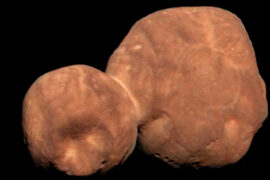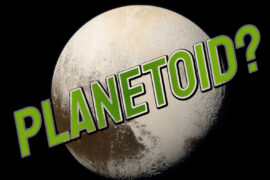So you got here wondering what is 16 psyche and why is it so important that everyone is talking about it? We got some answers for you.
16 Psyche (pronounce Sy-Kee) is one of the top ten biggest objects in the asteroid belt. On January 4, 2017, NASA announced it had approved a mission that will send a probe to orbit around it for 20 months.
The mission to launch the Psyche spacecraft was originally scheduled to launch on August 2022 and would arrive to the asteroid in 2026. Unfortunately, problems with the software and mission plan delayed it.
Recently NASA announced they will keep going with the program despite the delays and the new date has been set for October 10, 2023. The craft will launch on top of SpaceX’s Falcon Heavy rocket.
But there are a lot of asteroids in the aptly named asteroid belt. Why is NASA so interested in this one?
Well, that’s the interesting part.
NASA believes 16 Psyche isn’t like any of the other asteroids around it. They believe it could be the core of a planet that “died” in the early days of the Solar System.
This theory suggests this planet was hit by multiple collisions with other objects (at least more than 3). This impact had so much force that its outer layers of rock or gas got stripped, leaving only the inert core floating in space.
Now that’s cool.
If the theory is correct, it would allow astronomers to study what is basically the corpse of a planet, and it is conveniently located in our neighborhood. They could learn the secrets of how planets are formed, the composition of a planet’s core, and what happened to it.
Remember that while we are pretty sure Earth has a metal core, we don’t really have access to it because it is crazy hot. About 10,800 F hot. So this would be a great opportunity to learn more about it without having to go down there.
Here’s all the data we have so far about 16 Psyche on a handy fact sheet.
16 Psyche Fact Sheet
| Physical characteristics | |
| Diameter | 120 miles (200km) |
| Mass | 5.3 × 1019 pounds (2.41 x 1019 kg) |
| Density | 3.99 g/cm |
| Mean radius | 69.9 miles (112.5 km) |
| Surface area | 0.64 × 105 mi2 (1.658 × 105 km2 ) |
| Volume | 6.074 × 106 km |
| Distance from Earth | 223 to 344 million kilometers |
| Orbit | |
| Aphelion | 3.328 AU |
| Perihelion | 2.513 AU |
| Rotation period | 4.19 h |
| Eccentricity | 0.140 |
| Inclination | 3.095° |
| Mean anomaly | 323.379° |
| Brightness | |
| Aparent magnitude | 9.22 to 12.19 |
| Absolute Magnitude | 5.9 |
Frequently Asked Questions
Who discovered the asteroid 16 Psyche?
16 Psyche was discovered by Annibale de Gasparis, an Italian astronomer from Naples in the year 1852.
Where did 16 Psyche get its name from?
Psyche received its name after a Greek mythological figure from the myth of Cupid. In the story, Psyche was a beautiful mortal girl who had kind of a romance with Cupid, son Venus. This made Venus jealous and angry and she put Psyche through many hardships and trials. In the end, Cupid asks Jupiter to make Psyche immortal and give it to him in marriage, which Jupiter does.
The “16” prefix is added because it was the sixteenth of the minor planets to be discovered in chronological order.
Source: Encyclopedia Britannica
How far away is 16 Psyche?
Depending on the moment, Psyche is between 1.5 and 2.3 Astral Units from Earth. That is 223 million to 344 million kilometers (139 to 214 million miles). The reason why the distance is not constant is that the orbits of both Earth and 16 Psyche are elliptical so there are points in their orbits when they are farther away.
In order to launch the mission to 16 Psyche, NASA will have to wait until both orbits are at an optimal point on August 2022.
The following diagram might give you a better idea on where is Psyche located in the Solar System.

What is the planned goal of the Psyche mission?
By sending a spacecraft to Psyche, NASA hopes to learn the following:
- Find out if 16 Psyche is a planetary core
- Study an asteroid made mostly out of metal. (Most of the objects we have sent probes are made of ice and rock)
- Understand the composition of metallic objects. This will help us better understand Earth’s core.
- Determine the age and composition of 16 Psyche and its layers
- If Psyche 16 was a planet that got stripped of its outer layers, how did it happen?
- How craters in metal bodies differ from those on rock/ice objects?
There are some other, more specific scientific goals for the mission, but in general, those are the main objectives of sending a spacecraft to 16 Psyche.
How much gold is there on 16 Psyche?
The exact amount of precious metals in 16 Psyche is just a guess until further exploration gives us better numbers, but a calculation by oilprice.com estimates 16 Pysche could be worth $700 quintillion. This includes the estimated amounts of gold, platinum, and other precious metals in the asteroid.
When is the mission to Pysche going to land?
If the spacecraft launches as scheduled in October 2023, The Psyche spacecraft will reach the asteroid in late 2026 or early 2027. However, It will not land on the asteroid. All the research will be done from its orbit. It is expected that the mission will last for 21 months.
Mission to 16 Psyche
NASA approved the Psyche orbiter mission on January 4, 2017, after it became one of the semifinalists on a list of proposed projects for the Discovery program. The project’s planning started in early 2015 and the team is led by the planetary scientist Lindy Elkins-Tanton.
The original mission was supposed to launch on October, 2023, but thanks to some new calculations, a better launch window was found for August 2022 and so the project moved forward faster.
Unfortunately, the mission had issues with the software and the 2022 launch had to be canceled. Now the current plan is for the launch to happen in the original window of October 2023.
This new path will launch the orbiter and then use Mars’ gravity as assistance to propel it toward its final target.
It is expected the orbiter will arrive in Psyche in late 2026 where it will orbit for more than 21 months.
New communications system
One of the coolest things about the Psyche spacecraft is that it will be the first deep-space device to test a new type of communication technology developed by JPL (Jet Propulsions Laboratory, located in California).
This system named DSOC (Deep Space Optical Communications) will use light instead of radio signals to communicate with Earth. It will allow the spacecraft to send more information faster than any of the previous space probes.
Volcanoes of Molten Iron
One of the scientific goals of the mission to Psyche is to explore volcanoes created on metal-based planets. Scientists believe these volcanoes – if active -could literally erupt molten iron.
Now that’s metal.
Ferrovolcanism is only a theory at this point, but studying Psyche is one of our best shots at figuring out if it is a reality and how exactly does it work.
Psyche Spacecraft Photos
For now, we only have computer renderings of how the Psyche spacecraft is going to look like as it is still under construction. You can see these photos below.

Psyche 16 photo gallery
The following are photographs and renderings of the 16 Psyche asteroid and what we believe it looks like. Click the images for the high-resolution versions.




Gold and other precious metals on 16 Psyche
One of the reasons 16 Psyche has become so famous is because the media is pushing the narrative that the asteroid contains about $700 quintillion dollars in gold and other precious metals.
This is both true and false.
While it is correct that 16 Psyche is mostly made out of metal and that a big part of that can are what we consider to be precious metals (silver, gold, platinum, etc), the value isn’t realistic.
As this article on Forbes correctly points out, that’s not how economies work. Precious metals are valuable because they are scarce. If we were to mine an asteroid and extract so much gold, we would end up with a surplus of it, automatically making it way less valuable.
– So you are saying 16 Psyche isn’t going to make us all billionaires?
Sadly, no.
The second problem with space mining is energy.
It takes way too much energy to get to an asteroid and then mine it. This makes the costs of the operation enormous. The extracted metals would have to be sold for prices way higher than the same metals found on Earth in order to turn a profit. This makes the space mining operation not viable at the moment.
Maybe in the future when we can figure out cheaper energy sources space mining could be an option.
Conclusion
The Psyche orbiter mission is one of the most exciting projects currently at NASA. More information is still being released as the launch date approaches. We will make sure to update the article whenever new data comes up so make sure to bookmark the page.







